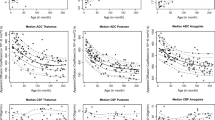Summary
The plagiocephaly index, an index that reflects an underlying anatomic asymmetry of the brain, was assessed in ten schizophrenic patients and its values were correlated with the lateral distribution of quantitatively evaluated EEG. The correlations between the index and alpha power at F7 were significant, positive for frontal asymmetry (frontal bulging) and negative for occipital flattening. We then studied ten normal subjects in an attempt to illuminate the contribution of several cephalic and cranial variables to the imbalance of alpha-afterdischarges (AD) of VEP recorded at O1–O2. The asymmetry index of AD was computed and correlated with asymmetries of CT-derived measures of occipital bone thickness, occipital lobe width, mastoid area, and sulcal asymmetry (the asymmetry of intraparietal sulcus location from the longitudinal fissure). With the exception of the sulcal variable all measures significantly covaried with alpha AD. These findings caution that it may be important to determine cranial and brain parenchymal asymmetries where brain laterality is pertinent to studies of EEG.
Similar content being viewed by others
References
Abraham, K. and Ajmone-Marsan, C. Patterns of cortical discharges and their relation to routine scalp electroencephalography. Electroenceph. Clin. Neurophysiol., 1958, 10: 47–461.
Binnie, C.D., Dekkerm E., Smit, A. and Vand der Linden, G. Practical considerations in the positioning of EEG electrodes. Electroenceph. Clin. Neurophysiol., 1982, 53: 453–458.
Clarren, S.K. Plagiocephaly and torticollis: Etiology, natural history, and helmit treatment. J. Pediat., 1981, 98: 92–95.
Cooper, R., Winter, A.L. and Walter, W.G. Comparison of subcortical, cortical and scalp activity using chronically indwelling electrodes in man. Electroenceph. Clin. Neurophysiol., 1965, 18: 217–228.
Coppola, R., Isolating low frequency components in EEG spectrum analysis. Electroenceph. Clin. Neurophysiol., 1978, 46: 224–226.
Coppola, R., Buchsbaum, M. and Regal, F. Computer generation of surface distribution maps of measures of brain activity. Comput. Biol. Med., 1982, 12: 191–199.
Gado, M., Hanaway, J. and Frank, R. Functional anatomy of the cerebral cortex by computed tomography. J. Comp. Assist. Tomogr., 1979, 3: 1–19.
Hintze, J.L. Number cruncher statistical system. Kaysville, Utah, 1988.
Homan, R.W., Herman, J. and Purdy, P. Cerebral location of international 10–20 system electrode placement. Electroenceph. Clin. Neurophysiol., 1987, 66: 376–382.
Flor-Henry, P. and Koles, Z.J. Statistical quantitative studies of depression, mania, schizophrenia and normals. Biol. Psychol., 1984, 19: 257–279.
Gotman, J., Gloor, P. and Ray, W.F. A quantitative comparison of traditional reading of the EEG and interpretation of computer-extracted features in patients with supratentorial brain lesion. Electroenceph. Clin. Neurophysiol., 1975, 38: 632–639.
Lansing, R.M. and Barlow, J.S. Rhythmic after-activity to flashes in relation to the background alpha which precedes and follows the photic stimuli. Electroenceph. Clin. Neurophysiol. 1972, 32: 149–160.
Leisnner, P., Lindholm, L.-E. and Petersen, I. Alpha amplitude dependence on skull thickness as measured by ultrasound technique. Electroenceph. Clin. Neurophysiol., 1970, 29: 392–399.
Mastaglia, F.L., Knezevic, W. and Thompson, P.D. Weakness of head turning in hemiplegia: A quantitative study. J. Neurol. Neurosurg. Psychiat., 1986, 49: 195–197.
Myslobodsky, M. Asymmetrie des symmetrischen Gehirnns. Ideen exact. Wiss., 1973, 8: 504–513.
Myslobodsky, M. Petit mal epilepsy. Academic Press:New York, 1976.
Myslobodsky, M. and Bar-Ziv, J. Location of occipital EEG electrodes verified by computed tomography. Electroenceph. Clin. Neurophysiol., 1989, 72: 362–366.
Myslobodsky, M., Coppola, R., Bar-Ziv, J. and Weinberger, D.R. Anatomical brain imaging as a guide for electrode placements: towards CT/MRI assisted electroencephalography. Int. J. Neurophysiol., 1989, (in press).
Myslobodsky, M., Bar-Ziv, J., Van Praag, H. and Glicksohn, J. Bilateral alpha distribution and anatomic brain asymmetries. Brain Topography, 1989, 1: 229–235.
Myslobodsky, M. Mintz, M., Ben-Mayor, V. and Radwan, H. Unilateral dopamine deficit and lateral EEG asymmetry: sleep abnormalities in hemi-Parkinson patients. Electroencephalogr. Clin. Neurophysiol., 1982, 54: 227–231.
Myslobodsky, M., Ingraham, L. and Weinberger, D.R. Skull asymmetry and handedness in adults: A possibility of their association with lateral head turning in infancy. Percept. Motor Skills, 1987, 65: 315–321.
Myslobodsky, M. and Weinberger, D.R. Brain asymmetry in schizophrenia and sighting dominance. In: Tackahashi et al. (Eds.), Cerebral dynamics, laterality and psychopathology. Amsterdam:Elsevier, 1987, 439–448.
Oldendorf, W.H. The quest for an image of brain. Raven Press:New York, 1980.
Petten, C.V. and Kutas, M. The use of event-related potentials in the study of brain asymmetries. Int.J.Neurosci., 1988, 39: 91–99.
Shapiro,R. and Janzen, A.H. The normal skull. Paul. B. Hoeber, 1960.
Author information
Authors and Affiliations
Rights and permissions
About this article
Cite this article
Myslobodsky, M.S., Coppola, R., Bar-Ziv, J. et al. EEG asymmetries may be affected by cranial and Brain parenchymal asymmetries. Brain Topogr 1, 221–228 (1989). https://doi.org/10.1007/BF01129599
Accepted:
Issue Date:
DOI: https://doi.org/10.1007/BF01129599




